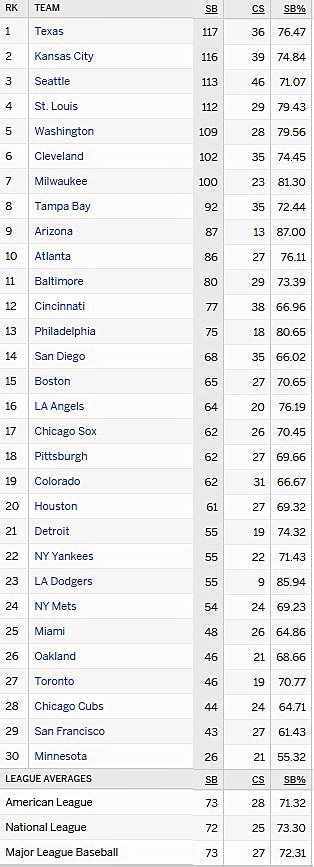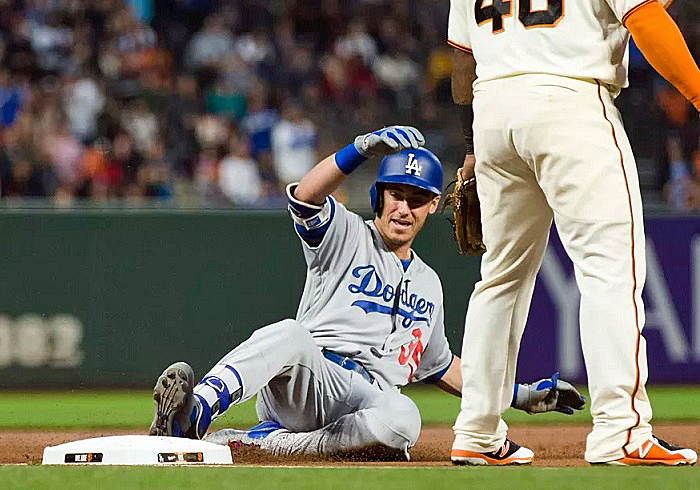Mention the name Maury Wills to any veteran (old) Dodger fan and one thing comes to mind – stolen bases. I mean, who can forget (or at least read about for you younger Dodger fans) that historic 1962 season when the then 29-year-old 5′-11″ / 170-pound Washington, DC native stole a then MLB-record 104 bases; a record that would stand for 12 years until broken by St. Louis Cardinals Hall of Fame outfielder Lou Brock in 1974, when he stole a seemingly impossible 118 bases.

(AP photo)
Brock’s record would eventually be topped by current (and probably forever) MLB stolen base record holder and Oakland A’s Hall of Fame outfielder Rickey Henderson in 1982 when he stole 130 bases. In fact, the last player to steal 100 or more bases in a season was St. Louis Cardinals outfielder Vince Coleman in 1987, when he swiped 109 bags. (He also stole 107 bases the year before and 110 the year before that).
In other words, stolen bases, at least a significant number of them, is absolutely positively a lost art – period.
Or is it?
As it stands, we will probably never again see anyone steal 100 bases in a single season; or 80; or perhaps even 60. In fact, the current MLB stolen base leader this season is 26-year-old Seattle Mariners outfielder Mallex Smith, who has 45 stolen bases with less than a week remaining in the 2019 regular season. However, it seems that the Dodgers have been attempting more stolen bases of late and doing so with noticeable success. As such and with my curiosity peaked due to the (perceived) increase in successful stolen bases by the Dodgers of late, I decided to delve into this topic deeper … and my suspicions were confirmed. The Dodgers are attempting more stolen bases lately and are surprisingly successful at it.
As of this writing, the Dodgers have attempted a combined 64 stolen bases (SB) this season and have been successful 55 times, while being caught stealing (CS) only nine times. This equates to an impressive success rate of 85.94% – the second-highest in Major League Baseball behind only the Arizona Diamondback’s 87.00% success rate.
Dodgers Stolen Bases in 2019:
- Cody Bellinger: 14 SB / 5 CS
- Chris Taylor: 8 SB / 0 CS
- Matt Beaty: 5 SB / 0 CS
- A.J. Pollock: 5 SB / 1 CS
- Kiké Hernandez: 4 SB / 0 CS
- Max Muncy: 4 SB / 1 CS
- Alex Verdugo: 4 SB / 1 CS
- Austin Barnes: 3 SB / 0 CS
- Justin Turner: 2 SB / 0 CS
- Gavin Lux: 2 SB / 0 CS
- Russell Martin: 1 SB / 0 CS
- Joc Pederson: 1 SB / 1 CS
- Corey Seager: 1 SB / 0 CS
- Will Smith: 1 SB / 0 CS
Dodgers Stolen Bases by Month in 2019:
- March/April: 7 SB / 4 CS
- May: 14 SB / 1 CS
- June: 8 SB / 2 CS
- July: 6 SB / 1 CS
- August: 8 SB / 1 CS
- September: 12 SB / 0 CS
In a game where a 70% failure rate at the plate will probably guarantee you baseball immortality in the sacred halls of Cooperstown, a 73.7% successful stolen base rate (as is Bellinger’s case) and a 100% success rate (as in Taylor’s and Beaty’s case) is certainly something that Dodgers manager Dave Roberts, an extremely successful base stealer during his playing days, should really be looking closely at with his team heading to the postseason for a seventh consecutive season. Yet as of this writing, the Dodgers and their 85.94% stolen base success rate rank 23rd in stolen bases in all of baseball this season.

(Courtesy of ESPN.com)
So why, then, isn’t Roberts calling for more stolen bases from his most successful base stealers? I asked Roberts this very question prior to Sunday’s 7-4 win over the Colorado Rockies at Dodger Stadium, his team’s final regular-season home game in which he called for zero stolen bases.
“I think that there’s been opportunities all year that we could have taken advantage of, but there’s a balance,” Roberts answered carefully. “I think that for me personally, I was obviously on the aggressive side as a player, but when you’re in this chair, you’re very mindful of health and potential risk.
“But I do like the way that we’ve been more aggressive on the bases, we have some guys that can steal a base if given the opportunity,” he added. “I like the success rate, but I think, though, with the primary leads, secondaries, I think that we can still do a better job at that.”
Clear as mud.
Or could it be that the Dodgers skipper hasn’t really given it much thought with his team heading into the final week of the regular season with a 100-56 record? If this is the case, shame on him, as he has several very good base stealers on his roster and in his daily starting lineups.

I fully get Roberts’ desire to keep his base-stealing strategies confidential, especially during the postseason when gamesmanship is at its highest. But failing to even attempt more stolen bases could be the difference in the Dodgers winning their first World Championship in 31 years, or losing their third straight.
I certainly know what Maury Wills – a three-time World Series champion and former MLB manager – would do if he were in that chair.
Play Ball!
* * * * *




 September 24th, 2019 at 8:00 am
September 24th, 2019 at 8:00 am  by Ron Cervenka
by Ron Cervenka  Posted in
Posted in 

great article Ron. i’ve been lamenting this for the three years he’s been here. i though we would definitely see more when he came on board. i would send the runners almost every time they were on the corners w/ less than 2 outs. especially if the runner on third is notably quicker than the runner on second. we have seen some of that lately and almost always without a throw down. its practically a free base and keeps the team out of GBDP danger.
The game has changed. Outs are too valuable to give up, especially when you have 6-7 thumpers in the lineup that can hit it out at any time. I loved Maury and Dave Lopes running virtually every time they were on, but it was a different game and a different time.
I think it’s great that the team has an 85% success rate when attempting steals, but a lot of that high % has to do with situational base stealing. They only go when stealing the bag is almost a sure thing. How many of those steals were “gimmee” steals when there was a runner on 1st and third and the opposition didn’t even attempt the throw? I would venture to say about 25% of them, but I’m too lazy to look it up.
Interesting article. Glad Wills isn’t in the managerial chair though. He may have been one of the worst managers ever, though that may be a bit unfair, considering the small sample size.
The Dodgers could take more bases on pitchers who are slow to the plate.
Beyond the numbers, Maury was a great distraction to the pitchers. They’d be thinking too much about him, pitching almost all fastballs, and Jim Gilliam was the master of taking advantage of it.
I’d love to see them playing that kind of game again.
As noted above, the uptick in power across the league has made stolen base attempts less common. “Get’em on, get’em over, get’em in” is simplified when one swing gets ’em in. However, I’d guess LA will attempt a few more steals in the post season, especially if they have a lead in a game, or in a series. The tactics of a short series amplify the pressure. Hopefully LA should have some practice withstanding and applying such pressure after the last few seasons.
Yes, those early 1960’s Dodgers teams lead the universe in steals. Walt Alston managed to the talent at hand.
In 1962 Maury stole 104 bases. By the end of the year he had scabbed sliding injuries that hadn’t healed all year. He played injured every day during the second half. He was a shortstop. Next to the catcher it is the most physically demanding position.
That team hit exactly 1/2 has many homeruns as the 2019 Dodgers – 140 vs 279. Tommy and Willie Davis has 27 and 21 homeruns respectively and never came close to those numbers again. Frank Howard was the only legit power hitter on the team.
But in the end Tommy Davis and later, Lou Johnson, paid the ultimate price for stealing bases. They bost suffered career altering knee and ankle injuries. They were never able to overcome the injuries.
A decade later Bill Buckner required two ankle surgeries due to sliding injuries that ended his speed game forever. Boston paid the price in the 1986 World Series. Two decades later Pedro Guerrero paid the same price when he broke his ankle sliding at third.
Over his career Maury Wills was thrown out stealing 26.2% of the time (208 CS). That’s 208 potential failed innings. But Walt played the hand he was dealt: He had the best starting pitching in the MLB, excellent defense, excellent team speed but below average offense in an 8 team National League.
You steal bases when you can’t jump the yard. You don’t steal bases simply because you can. The 2019 Dodgers can jump the yard. They have outscored their opponents by almost 270 runs. They’ve won 105 games.
Dave Roberts isn’t missing out on using a tool that happens to be in the toolbox. It’s just not called for.
And his answer wasn’t “clear as mud”. It was crystal clear. He talked about primary and secondary leads and that the team needs to do a better job there. Stealing a base is accomplished with an excellent primary lead and an excellent first step into the secondary. Otherwise its a CS.
GREAT stroll down Memory Lane! All of the names you mentioned were my childhood Dodgers!
There is one thing that you are (perhaps) overlooking – take-out slides and blocking bases which, of course, is no longer allowed.
Don’t know if there is any way to research it or not, but I’d be willing to bet that many – perhaps even most – of those injuries you mentioned were because sliding lanes were simply not there back then as they are now required.
I will never forget that Tommy Davis injury you mentioned. He was one of my all-time faves … as was ‘Hondo.’
Thanks for the GREAT reply!